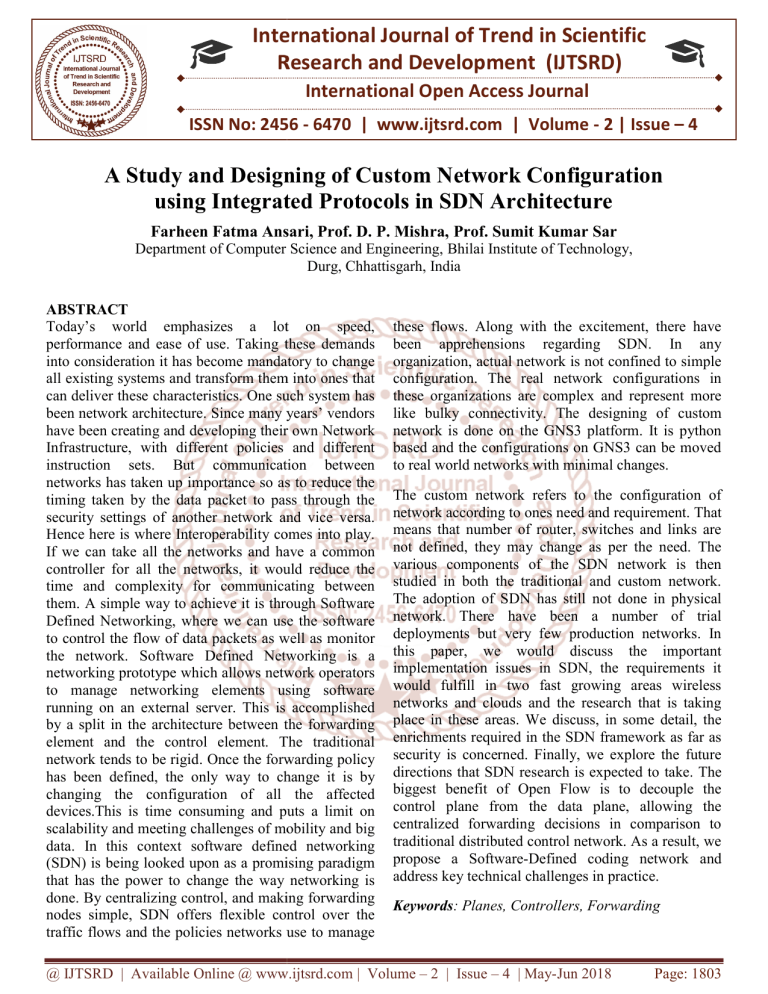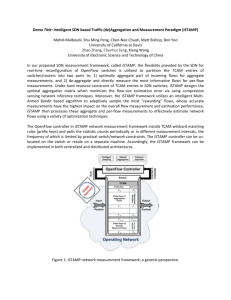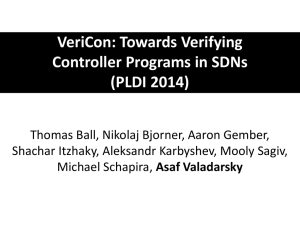
International Journal of Trend in Scientific
Research and Development (IJTSRD)
International Open Access Journal
ISSN No: 2456 - 6470 | www.ijtsrd.com | Volume - 2 | Issue – 4
A Study and Designing of Cus
Custom
tom Network Configuration
using Integrated Protocols in SDN Architecture
Farheen Fatma Ansari
Ansari, Prof. D. P. Mishra, Prof. Sumit Kumar Sar
Department of Computer Science and Engineering, Bhilai Institute of Technology,
Durg, Chhattisgarh, India
ABSTRACT
Today’s world emphasizes a lot on speed,
performance and ease of use. Taking these demands
into consideration it has become mandatory to change
all existing systems and transform them into ones that
can deliver these characteristics. One such system has
been network architecture. Since many years’ vendors
have
ve been creating and developing their own Network
Infrastructure, with different policies and different
instruction sets. But communication between
networks has taken up importance so as to reduce the
timing taken by the data packet to pass through the
security
urity settings of another network and vice versa.
Hence here is where Interoperability comes into play.
If we can take all the networks and have a common
controller for all the networks, it would reduce the
time and complexity for communicating between
them. A simple way to achieve it is through Software
Defined Networking, where we can use the software
to control the flow of data packets as well as monitor
the network. Software Defined Networking is a
networking prototype which allows network operators
to manage
age networking elements using software
running on an external server. This is accomplished
by a split in the architecture between the forwarding
element and the control element. The traditional
network tends to be rigid. Once the forwarding policy
has been defined, the only way to change it is by
changing the configuration of all the affected
devices.This is time consuming and puts a limit on
scalability and meeting challenges of mobility and big
data. In this context software defined networking
(SDN) is being
ing looked upon as a promising paradigm
that has the power to change the way networking is
done. By centralizing control, and making forwarding
nodes simple, SDN offers flexible control over the
traffic flows and the policies networks use to manage
these flows.
lows. Along with the excitement, there have
been apprehensions regarding SDN. In any
organization, actual network is not confined to simple
configuration. The real network configurations in
these organizations are complex and represent more
like bulky connectivity.
ectivity. The designing of custom
network is done on the GNS3 platform. It is python
based and the configurations on GNS3 can be moved
to real world networks with minimal changes.
The custom network refers to the configuration of
network according to ones need and requirement. That
means that number of router, switches and links are
not defined, they may change as per the need. The
various components of the SDN network is then
studied in both the traditional and custom network.
The adoption of SDN has still not done in physical
network. There have been a number of trial
deployments but very few production networks. In
this paper, we would discuss the important
implementation issues in SDN, the requirements it
would fulfill in two fast growing areas wireless
networks and clouds and the research that is taking
place in these areas. We discuss, in some detail, the
enrichments required in the SDN framework as far as
security is concerned. Finally, we explore the future
directions that SDN research is expected to take. The
biggest benefit of Open Flow is to decouple the
control plane from the data plane, allowing the
centralized forwarding decisions in comparison to
traditional distributed control network. As a result, we
propose a Software-Defined
Defined coding network and
a
address key technical challenges in practice.
Keywords: Planes, Controllers, Forwarding
@ IJTSRD | Available Online @ www.ijtsrd.com | Volume – 2 | Issue – 4 | May-Jun
Jun 2018
Page: 1803
International Journal of Trend in Scientific Research and Development (IJTSRD) ISSN: 2456-6470
1. INTRODUCTION
Due to blistering evolution of the internet, nowadays
there is a tremendous increase in the complication of
the network architecture. The network operators are
struggling and working hard to manage the
challenges of the network with the merging of
various types of networks. Networks typically consist
of large number of network devices like switch,
routers and many middle-boxes.
The traditional network tends to be inflexible. The
only way to change the configuration in case of
failure is by changing the devices. This is a tedious
time consuming task and the traditional network is
not able to meet the requirements of the network. As
an optimized solution, there comes the Software
Defined Network(SDN).
Software-defined networking (SDN) is an evergrowing technology that allows the design and
implementation of more flexible and programmable
networks. In the past several years, both researchers
and vendors have shown tremendous interest on SDN
technology.SDN is a disruptive technology that
completely redefines the management of computer
networks. It is an emerging network technology that
supports the separation of control and data plane
allowing direct programmability. In SDN, the
intelligence of the network is centralized in the
software based controllers and the other networking
entities acts as normal forwarding devices. Controller
has the global view of the network topology and has
absolute control over the forwarding elements.
Typical network devices such as switches contain two
main components: control plane and data plane.
Control plane computes forwarding paths of
incoming packets with prebuilt network protocols.
Data plane sends those packets to the next hop
defined in the forwarding paths. Modification of the
network configuration has to be done via command
line tools or web console manually. It is difficult to
obtain a global view of the whole network.
Furthermore, it is inefficient to change the
configuration of switches at runtime.
The core and most attractive idea of SDN is to
decouple control planes from physical switches.
Software-defined control planes such as SDN
controllers run on servers and centralize the
management of network devices and data flows.
2. PROBLEM IDENTIFICATION
There are various studies done on the concept and
implementation of SDN. Many researchers have spent
time on its simulation and emulation platform too.
Tests are being conducted to study the SDN emulation
tool called Mininet. Many topologies are tested with
varying number of routers, switches and nodes. But
the research work is not done in the area to provide
best network configuration with the best suited
topology for the implementation of SDN network.
Due to stepping in the compacted approach, the
reason behind the influence of topology and number
of connected switches is yet to be clarified. Network
configurations has also effected the processing time of
SDN controllers, so it becomes a critical need of the
day to find or generate such network that supports the
SDN’s concept and gives an outstanding performance
without delay.
The emulation tool called GNS3 is a network software
emulator first released in 2008.It allows combination
of virtual and real devices. The main specialty is to
simulate complex networks. It uses Dynamips
emulation software to simulate Cisco IOS. It is
written in Python Language. It is used by many large
companies including Exxon, Walmart, At &T &
NASA. It is also popular for preparation of Network
Professionals certification exams. GNS3 allows to
visualize, plan, test and troubleshoot network
environments across any vendor platform at scalewithout the need to directly interact with the network
hardware. But here with the intuitive graphical
interface, we can seamlessly connect all types of
virtual interfaces to compose a real representation of
networks.
With the advancement of GNS3, we are going to
study and configure custom network with the help of
various types of protocols. This custom network can
be changed according to the need of the operator and
the network. The custom network is not defined by
any standard design or certainty. There has been
terrific effect of configuration in the traffic, variance,
cost of the network and security concerns. Thus here
we provide the configuration of custom network and
also give an idea about the better performance of the
SDN network by comparison with the traditional
network. To create custom network, we have to study
about the existing GNS3 or we must have good
knowledge of python language.
@ IJTSRD | Available Online @ www.ijtsrd.com | Volume – 2 | Issue – 4 | May-Jun 2018
Page: 1804
International Journal of Trend in Scientific Research and Development (IJTSRD) ISSN: 2456-6470
Here in this paper, the creation of custom network is
done on the existing GNS3 tool by dragging and
dropping network devices, and then ensuring the best
configuration for implementing SDN by comparing
this custom network with the traditional network on
the bounds like cost, variance, traffic analysis and
time taken for creation of network (start/stop) and
security concerns. The name custom network defines
the charter which enables the creation of any
customized network according to the need and
requirement.
This paper lays the emphasis on the creation of
custom network and the comparative study with
traditional network to find the best network platform
for the application of SDN. The simulation tool here
used for the creation of network is GNS3. This
research paper enables the users to implement SDN
on the custom network configuration to get the best
performance and thus reduce the traffic.
3. METHODOLOGY
The paper speaks of the configuration of Custom
Network and then having a comparative study with
the traditional network to find the better performance
of the SDN network. The main emphasis lay on the
designing of the network in the GNS3 tool. There are
some methods which need to be considered before
configuring the network. So, firstly we should take a
look into this things: 1) Installing GNS3 Tool
2) Dragging & Dropping components
3) Configuring
4) Consoling
5) Running
6) Installing Wireshark
7) Analyzing Packet traffic
Fig.3.2 Packet capturing in Wireshark
The paper proceeds by the configuration of Custom
Network. Then having a comparative study with the
traditional network to find the better performance of
the SDN network.
The main emphasis lay on the designing and
configuration of the network in the GNS3 tool.
Moreover, firstly we create a small network and ping
IP address to check whether tool is working on a
local server or not. If no other option could be
choosed as GNS3 VM too.
4.
COMPARITIVE
STUDY
WITH
TRADITIONAL NETWORK
In the projected framework, any network can be
configured according the need of user and
requirement of network that resembles the real
network where the implementation has to be done.
GNS3, by default, with the intuitive graphical
interface users can seamlessly connect all types of
virtual interfaces to compose a real representation of
networks.
The Customized Network can be configured either by
configuring on the existing GNS3 tool or writing
command in console or code in python language in
the existing GNS3. This work has done in the area of
enhancing the existing Mininet for configuration of
custom network. Here we propose the creation of
custom network in the existing GNS3 so that there
shouldn’t be the need of upgrading.
Fig. 3.1 Network Configuration in GNS3
Workspace
All the links can be specified as configuration data
and this file is captured as command line file in
Wireshark by invoking the GNS3. The work also
allows the operator to provide parameter details like
delay, bandwidth and packet loss. These values can
be specified and even changed according to ones
need in custom network. At the time of network
@ IJTSRD | Available Online @ www.ijtsrd.com | Volume – 2 | Issue – 4 | May-Jun 2018
Page: 1805
International Journal of Trend in Scientific Research and Development (IJTSRD) ISSN: 2456-6470
configuration, the link details are taken from the
configuration file and network is created
corresponding to these specified values. After the
creation of custom network, the comparative study is
done with the traditional network configuration to
find the betterment of the SDN. The study is done to
find the amount of traffic analysis, capturing in
wireshark, processing time and throughput of the
custom network.
5. RESULT AND DISCUSSION
The main objective of our project was to create
Custom Network. The configuration of any of the
networks according to the need of the customers or
the users is termed as Custom Network. The GNS3
GUI tool by default supports this type of
configuration of the networks. And the creation of
Custom Network can be done by little changes in the
configuration file or by using python commands.
Moreover, by writing certain command on the console
we can configure such networks. One advantage of
using GNS3 tool was real and virtual part in terms of
network components. The custom network supports
the change in topology according to the need of user
and demand of the network. The number of switches,
nodes and controller once deployed could be changed
as per the need after implementation. In this type of
networks, the architecture does not remain defined
and can be altered if one needs to configure more no
of elements according to need. Thus the creation of
Network that can be changed in variance with the
demand is the need of today’s network.
here is Wireshark. Hence we can see all the
parameters like traffic, delay and time easily in this.
6. CONCLUSION AND FUTURE SCOPE
SDN is presented as one of the effective technology
for controlling and managing the complex network by
configuring the program in the external server. The
SDN supports the separation of data plane and control
plane. The data plane includes the components like
switches, routers and other middle-boxes. These all
devices just act as normal forwarding elements. The
decision making capacity of device is being extracted
and shifted to a centralized server called controller.
The centralized server has the complete view of the
topology and thus it monitors and manages the
network flow. The emulation tool called GNS3 is
used for the simulation of SDN. This tool directly
runs on your laptop or desktop. GNS3 helps to
configure a network composed of hosts, switches, and
a router; being intuitive graphical interface software
makes the response time faster and easier to use.
GNS3 is free to download and is open source software
that emulates Open Flow devices and Software
Defined network controllers. By GNS3 being an
emulator it is able to visualize, plan, test and
troubleshoot network environments across any vendor
platform at scale-without the need to directly interact
with the network hardware. With the attractive user
friendly interface, users can seamlessly connect all
types of virtual interfaces to compose a real
representation of networks. GNS3 runs on traditional
PC hardware and may be used on multiple operating
systems, including Windows, Linux & MacOSx.
This paper summarizes the various aspects of the
SDN and creation of custom network. The
comparative study shows that the custom network is
best for the implementation of SDN network. The
result showed that the traffic analyzed in the created
network is reduced.
Fig. 5.1 Custom Network
The main focus of discussion is why are we
designing Custom Networks? So, the best answer to
this is that we are required with such network for
Customers with which they can easily fulfill their
needs without any worries. Therefore, after creation
and configuration of Custom Network, we were
required to capture packets from the configured
Network. For this purpose, the Display Monitor used
SDN deployment in the physical network provides
great platform for research area related to provide
security in the controller level. This paper presented
that the configuration of custom network is suitable
for the application of the SDN. But various algorithms
like spanning tree algorithm to solve the loop problem
is not discussed here.
The main focus of the research work is done on
finding the best configuration for SDN, so that best
performance can be obtained after implementing SDN
@ IJTSRD | Available Online @ www.ijtsrd.com | Volume – 2 | Issue – 4 | May-Jun 2018
Page: 1806
International Journal of Trend in Scientific Research and Development (IJTSRD) ISSN: 2456-6470
concerned with traffic analysis. This works motivates
us to adopt SDN network with supporting custom
network configuration in our college campus as well
as in hospitals for surveillance purpose.
Thus we can conclude the work by saying that the
parameter of SDN gives outstanding performance in
the custom network as well as the GNS3 is the user
friendly tool for the emulation of SDN network.
7. REFERENCES
1) M. Jarschel, T. Zinner, T. Hoßfeld, P. Tran-Gia,
and W. Kellerer, “Interfaces, Attributes, and Use
Cases: A Compass for SDN,” IEEE
Communications Magazine, 2014.
2) N. McKeown, T. Anderson, H. Balakrishnan, G.
Parulkar, L. Peterson, J. Rexford, S. Shenker, and
J. Turner, “OpenFlow: Enabling Innovation in
Campus Networks,” SIGCOMM CCR, 2008.
3) A. Tootoonchian and Y. Ganjali, “HyperFlow: a
Distributed Control Plane for OpenFlow,” in
INM/WREN’10, Berkeley, CA, USA, 2010.
4) M. F. Bari, A. R. Roy, S. R. Chowdhury, Q.
Zhang, M. F. Zhani, R. Ahmed, and R. Boutaba,
“Dynamic Controller Provisioning in Software
Defined Networks,” in International Conference
on Network and Services Management (CNSM),
Z¨urich, Switzerland, 2013.
5) B. Heller, R. Sherwood, and N. McKeown, “The
Controller Placement Problem,” in HotSDN ’12,
New York, NY, USA, 2012.
6) D. Hock, M. Hartmann, S. Gebert, M. Jarschel, T.
Zinner, and P. Tran- Gia, “ParetoOptimal
Resilient Controller Placement in SDN-based
Core Networks,” in 25th International Teletraffic
Congress (ITC), 2013.
7) D. Hock, M. Hartmann, S. Gebert, T. Zinner, and
P. Tran-Gia, “POCOPLC: Enabling Dynamic
Pareto-Optimal Resilient Controller Placement in
SDN Networks,” INFOCOM, Toronto, Canada,
2014.
8) Stanislav Lange, Steffen Gebert, Thomas Zinner,
Phuoc Tran-Gia, David Hocky, Michael
Jarschelz, and Marco Hoffmannz,’’ Heuristic
Approaches to the Controller Placement Problem
in Large Scale SDN Networks,’’ University of
Wurzburg, Institute of Computer Science, Chair
of Communication Networks, Wurzburg,
Germany,2015.
9) P. Czyazak and A. Jaszkiewicz, “Pareto
simulated annealing - a metaheuristic technique
for
multiple-objective
combinatorial
optimization,” Journal of Multi-Criteria Decision
Analysis, 1998.
10) Karamjeet Kaur, Japinder Singh and Navtej
Singh Ghumman, “Mininet as Software Defined
Networking Testing Platform”, International
Conference on Communication, Computing
Systems (ICCCS2014).
@ IJTSRD | Available Online @ www.ijtsrd.com | Volume – 2 | Issue – 4 | May-Jun 2018
Page: 1807






